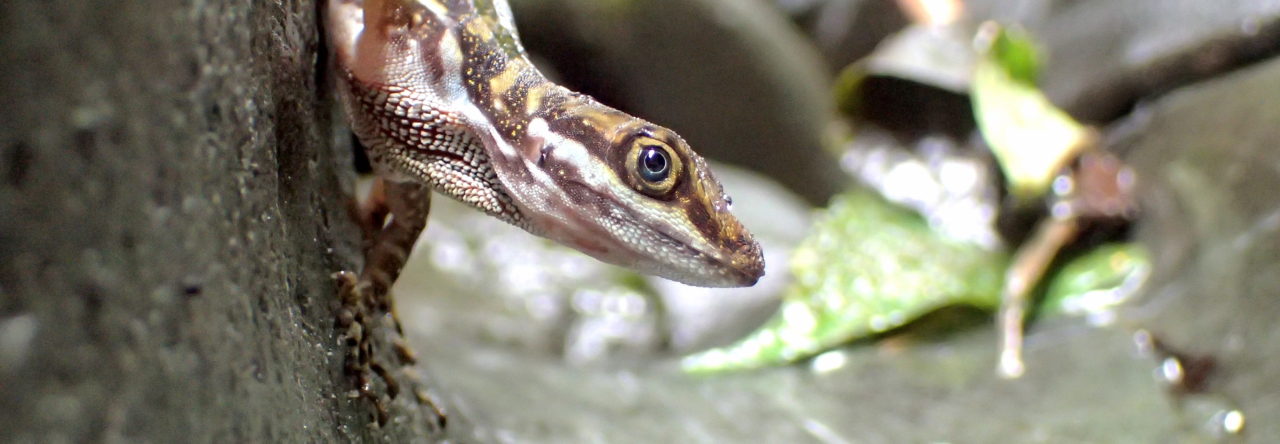
Figure 1. Anolis cupreus.
Spending two weeks searching for amphibians and reptiles along Nicaragua’s southern border proved very successful for a band of nature enthusiasts. Accompanied by my primatologist wife Barbara, fellow herpetologist, Joe Furman and his daughter Sadie, and our expert guide Lenin, we visited several nature reserves hoping to observe as many species of herps as possible. Our journey began in Ticuantepe, at the Montebelli Reserve, where we spent our first night searching the forest for any creatures that were out and about. The rainy season had not yet begun and the lack of rain resulted in a paucity of herpetological sightings. We did manage to find a few frogs (Smilisca baudinii and Scinax staufferi), a small fossorial snake (Enulius flavitorques), as well as a sleeping Copper Anole, Anolis cupreus (Fig. 1). Our stay here was brief and the following day we were on our way to the Ecological Center of Los Guatuzos, near the town of Papaturro.

Figure 2. Anolis limifrons.
The forests here were much more expansive and bordered the Papaturro River. and as a result the abundance of amphibians and reptiles was significantly greater. The river, which ran immediately in front of our accommodations, contained large numbers of Spectacled Caimans (Caiman crocodilus), ranging from yearling size to two meter long adults. At night their glowing orange eyes could clearly be seen scattered throughout the waterway like dim headlights on a busy thoroughfare. On our first night’s outing we observed more than a dozen species of amphibians and reptiles including the iconic Red-eyed Treefrog (Agalychnis callidryas), Fleischmann’s Glass Frog (Hyalinobatrachium fleischmanni) , the giant Smoky Jungle Frog (Leptodactylus pentadactylus), Clouded Snail-eating Snake (Sibon nebulatus), and two species of anoles: Slender (Anolis limifrons Fig 2.), and the Neotropical Green Anole (Anolis biporcatus Fig 3.).

Figure 3. Anolis biporcatus.

Figure 4. ???.
The following night we came upon an almost white-colored male anole (Fig. 4) sleeping on a leaf some two meters above the ground that we couldn’t readily identify. We realize that many anole species have different body color and patterns at night than they do during the day, so we decided to check the dewlap to see if that might help us render a positive identification. The dewlap was mostly light in coloration with several dark green spots scattered throughout (Fig. 5). Despite this characteristic coloration, the species remained unknown to us.

Figure 5. Dewlap of unidentified white anole in Fig. 4.

Figure 6. Second unidentified white anole.
Shortly after finding this anole, another unidentified white anole was observed (Fig. 6) however, this one had a bright orange-colored dewlap (Fig. 7).
Our final destination took us up the Rio Bartola to the Reserva Naturale Indio Maiz. Like our previous sites this one had large, expansive forests with no other visitors anywhere in the vicinity. Fortunately, the rains had now begun and we were treated to a greater diversity of wildlife including more than two dozen species of amphibians and reptiles. Perhaps due to the onset of the rains or maybe because this reserve is naturally abundant in snake fauna, we ended up seeing more than a dozen serpents in just a few days time. Most notable among them was the seldom seen White-headed Snake, or Panda Bear Snake (Enuliophis sclateri Fig 8), a small fossorial species known from only four other individuals from Nicaragua.

Figure 8 Enuliophis sclateri, White-headed Snake
Six species of anoles were found here including the mossy-looking Anolis capito (Fig. 9), the Slender Anole (Anolis limifrons), the Lion Anole (Anolis lionotus Fig. 10), of which several were observed during the day on rocks in a shallow stream as well as at night on thin branches overhanging the waterways, a species we were unfamiliar with but which our guide identified as Anolis quaggulus (Fig 11).














